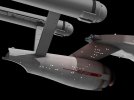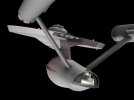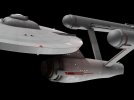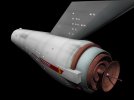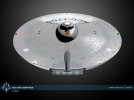I believe that it was Vektor*, a magnificiently talented artist who used to post on TrekBBS, who built a 3DMax version of the Constitution based upon the Franz Joseph blueprints.
I'm sure there are variances, but Joseph appeared to have based most of the exterior contours of his ship on the Jefferies scale drawing.
Unfortunately, the model was built in a now-outdated file format. With his permission, I did a partial conversion of the mesh to Lightwave back in 2004, for use as the wrecked U.S.S. Kongo in the fan film Starship Exeter: The Tressaurian Intersection.
IIRC, I converted only the engineering hull and nacelles since that was all that survived per the storyline.** And then I modified the details of the model to suggest a ship that might have been refit as a more advanced vessel than the Enterprise or Exeter. So in the work image below, you see things like a ST:TMP glowing deflector dish.
Be that as it may, you can also see the different curvature and proportions of the Jefferies' drawing represented in the image:
View attachment 43019
View attachment 43020
Since canon sources contradict each other as to the ship's dimensions (and much of Trek's canon is self-contradictory) I'm perfectly happy with the SNW scale of 442 meters. The ship's size was apparently quietly retconned in the last days of the Roddenberry/Berman era, and the larger scale makes more sense.
*I'm not sure it was him. If someone else is the actual artist and they're still active on the board, I hope they'll see this and correct my error.
**The grounded saucer also appears, but it was a physical model that was painted over as part of a matte.
Thanks - Vektor does wonderful work but as you note, FJ's plans has some variances from MJ's plans. Even though FJ took the engineering hull curvature and the BC deck the saucer rim, bridge and other bits are different.
Still seems odd to me that more 3D artists have built FJ's version than MJ's after all this time
 (Google doesn't seem to find any builds of MJ's version.)
(Google doesn't seem to find any builds of MJ's version.)





